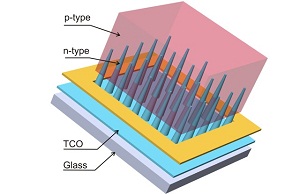The newest nanosolar on the block? Nanocones
 Researchers at the Oak Ridge National Laboratory have developed a new, three-dimensional photovoltaic technology using minuscule devices called nanocones to convert sunlight into electricity. The nanocones have increased the conversion efficiency of photovoltaics by 80 percent in lab testing.
Researchers at the Oak Ridge National Laboratory have developed a new, three-dimensional photovoltaic technology using minuscule devices called nanocones to convert sunlight into electricity. The nanocones have increased the conversion efficiency of photovoltaics by 80 percent in lab testing.
A lot of attention in the solar world these days is on photovoltaics with carbon nanotubes, like recent research from MIT using viruses to arrange and coat nanotubes.
But Dr. Jun Xu, Ph.D., and his team in the Oak Ridge’s Chemical Sciences Division, including Sang Hyun Lee, have developed nanocones made of zinc oxide that increase the efficiency of photovoltaics.
“It does not use nanotubes. It uses zinc oxide cones. Our efficiency is among the highest [in nanostructure photovoltaics]. That's what we're excited about,” Xu said.
The research was focused on cadmium telluride-based photovoltaics.
“The material is not new. But the structure is,” he said. “It is a combination of zinc oxide [nanocones] and cadmium telluride [film].”
The nanocones conduct electrons produced by the cadmium telluride, which absorbs photons.
The cones allow the photovoltaic device to create an electric field distribution that efficiently transports the charge generated by the device. The field minimizes trapping of photo-generated charges, Xu said.
“The cone allows a greater yield of charge collection, because the field can drive minority carriers—electrons—moving to their electrode,” he said.
The team was able to boost the performance of the light-to-power conversion efficiency from 1.8 percent in a flat surface of the same materials to 3.2 percent using the nanocones, according to Oak Ridge, an efficiency increase of 80 percent.
Since the technology increases the efficient charge transport, the photovoltaic device could also tolerate defective materials, the lab said, helping it to reduce the costs of fabrication.
The technology is still not ready for the commercial market, but the material shouldn’t be too expensive to make.
The nanocones are also self-assembling, according to Xu.
“That's why there's the potential to save the costs on manufacturing,” he said.
But Xu estimated that the device would not be ready for the commercial market for another four or five years.
Image courtesy of the Oak Ridge National Laboratory.



